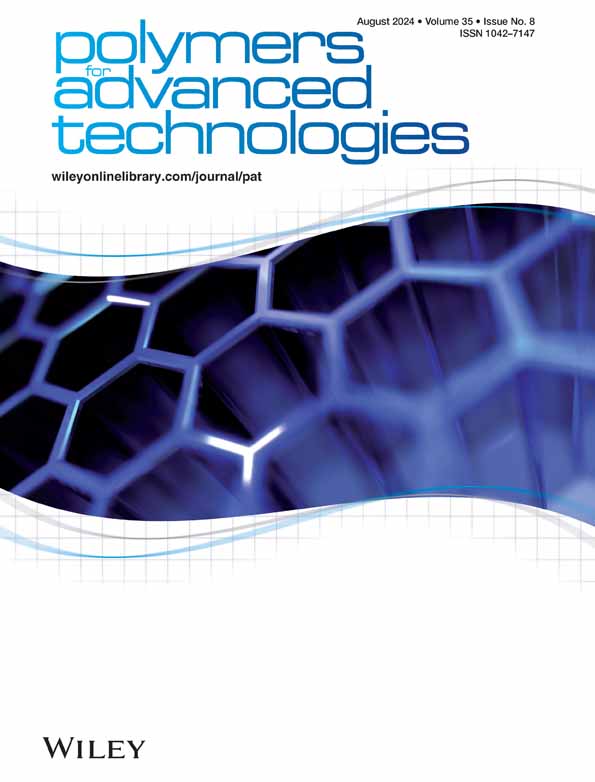实现柔性电子:集自愈合、防紫外线、可再加工和可降解特性于一体的新型聚氨酯
IF 3.4
4区 工程技术
Q2 POLYMER SCIENCE
引用次数: 0
摘要
柔性电子技术是现代社会的发展方向,它对电子封装基板的柔性提出了苛刻而迫切的要求。然而,包括陶瓷、金属或聚合物在内的传统材料都缺乏柔韧性。本文提出了一种名为 PU-D1Q1VF1 的聚氨酯,通过加入精心挑选的生物基单元和协同动态键,PU-D1Q1VF1 不仅能满足柔韧性的基本要求,还具有自愈、防紫外线、可再加工和可降解等特性。聚己内酯二醇(PCL 二醇)被用作软段,双(2-羟乙基)二硫化物(HEDS)和木质素衍生的模型单体对苯二酚被用作扩链剂。此外,还采用了精心合成的生物基单体 (E)-4-(((呋喃-2-基甲基)亚氨基)甲基)-2-甲氧基苯酚 (VF) 作为封端剂,从而促进了 PU-D1Q1VF1 的自愈合过程。本文章由计算机程序翻译,如有差异,请以英文原文为准。
Toward flexible electronics: A novel polyurethane integrating self‐healing, UV‐protective, reprocessable, and degradable properties
Flexible electronics are striving in modern society, and they impose harsh and urgent requirements for flexibility on electronic package substrates. However, traditional materials, including ceramics, metals, or polymers are lack of flexibility. Herein, a polyurethane named PU‐D1Q1VF1 is proposed via incorporating carefully selected biobased units and synergistic dynamic bonds, and the PU‐D1Q1VF1 not only meets the basic requirements of flexibility but also possesses properties of self‐heal, UV‐protection, reprocessability, and degradability. The polycaprolactone diol (PCL diol) was employed as the soft segment, and the bis(2‐hydroxyethyl) disulfide (HEDS) and lignin derived model monomer hydroquinone were selected as chain extenders. Moreover, carefully synthesized bio‐based monomer (E)‐4‐(((furan‐2‐ylmethyl)imino)methyl)‐2‐methoxyphenol (VF) was used as the capping agent, which could facilitate the self‐healing process of the PU‐D1Q1VF1.
求助全文
通过发布文献求助,成功后即可免费获取论文全文。
去求助
来源期刊

Polymers for Advanced Technologies
工程技术-高分子科学
CiteScore
6.20
自引率
5.90%
发文量
337
审稿时长
2.1 months
期刊介绍:
Polymers for Advanced Technologies is published in response to recent significant changes in the patterns of materials research and development. Worldwide attention has been focused on the critical importance of materials in the creation of new devices and systems. It is now recognized that materials are often the limiting factor in bringing a new technical concept to fruition and that polymers are often the materials of choice in these demanding applications. A significant portion of the polymer research ongoing in the world is directly or indirectly related to the solution of complex, interdisciplinary problems whose successful resolution is necessary for achievement of broad system objectives.
Polymers for Advanced Technologies is focused to the interest of scientists and engineers from academia and industry who are participating in these new areas of polymer research and development. It is the intent of this journal to impact the polymer related advanced technologies to meet the challenge of the twenty-first century.
Polymers for Advanced Technologies aims at encouraging innovation, invention, imagination and creativity by providing a broad interdisciplinary platform for the presentation of new research and development concepts, theories and results which reflect the changing image and pace of modern polymer science and technology.
Polymers for Advanced Technologies aims at becoming the central organ of the new multi-disciplinary polymer oriented materials science of the highest scientific standards. It will publish original research papers on finished studies; communications limited to five typewritten pages plus three illustrations, containing experimental details; review articles of up to 40 pages; letters to the editor and book reviews. Review articles will normally be published by invitation. The Editor-in-Chief welcomes suggestions for reviews.
 求助内容:
求助内容: 应助结果提醒方式:
应助结果提醒方式:


